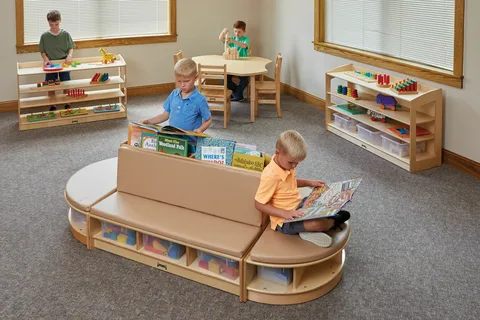Montessori education emphasizes self-directed learning, where children explore their environment and learn through hands-on experiences. A vital part of this approach is Montessori kids furniture, which creates an environment designed specifically for children. This blog explains how Montessori furniture encourages independent learning and why it’s an essential tool for any Montessori-inspired home or classroom.
What Is Montessori Kids Furniture?
Montessori kids furniture is furniture that is thoughtfully designed to match the needs and abilities of children. It is child-sized, lightweight, and easy to use. Unlike traditional furniture, which often requires adult assistance, Montessori furniture allows children to perform daily tasks on their own, such as choosing books from a shelf or sitting at a table to draw. This empowers kids to explore and learn independently.
Why Is Independent Learning Crucial for Children?
1. Builds Confidence
When children are encouraged to learn independently, they develop self-confidence. They begin to trust their abilities, whether it’s putting away toys or completing an activity without help. This confidence fosters resilience and a willingness to try new tasks.
2. Develops Problem-Solving Skills
Independent learning allows children to tackle challenges on their own, teaching them how to think critically and solve problems. Montessori furniture creates an environment where they can explore solutions without adult intervention.
3. Encourages Responsibility
When children are given tools to manage their own environment, they naturally take ownership of their space. This sense of responsibility carries over into other areas of their lives, such as schoolwork and relationships.
How Does Montessori Kids Furniture Encourage Independence?
1. Child-Sized Design for Accessibility
Montessori furniture is designed to be the perfect size for young children. Chairs, tables, and shelves are scaled down so children can sit, work, and access items comfortably. For instance, a low shelf allows a toddler to pick out their favorite toy or book without asking for help. This simple act of self-reliance builds their independence over time.
2. Promotes Order and Organization
Montessori furniture often includes open shelves and storage options that encourage children to organize their belongings. By having a designated place for each item, kids learn to clean up after themselves and maintain order in their environment. This habit, taught early, becomes a lifelong skill.
3. Encourages Freedom of Movement
Traditional furniture can restrict a child’s movements, making them reliant on adults to adjust their surroundings. Montessori furniture is lightweight and easy to move, enabling children to rearrange their space based on their needs. This freedom allows them to take control of their environment, boosting their confidence.
4. Supports Practical Life Skills
A child-sized table can become a workstation for art, a place to eat, or even a setup for pretend play. These practical uses help children engage in everyday activities, such as setting the table or drawing, without needing constant supervision. This supports hands-on learning and the development of life skills.
5. Empowers Decision-Making
When children have easy access to materials and tools, they can make their own choices about what to play with or work on. This autonomy helps them develop decision-making skills and a sense of responsibility for their actions.
Types of Montessori Kids Furniture That Encourage Independent Learning
1. Low Shelves
Low shelves are a cornerstone of Montessori spaces. They allow children to see and choose their toys, books, or learning materials without assistance. This freedom helps them develop independence and encourages self-motivation.
2. Child-Sized Tables and Chairs
These are ideal for various activities, from eating to crafting. Their small size ensures that children can sit and stand up without adult help, promoting independence in daily tasks.
3. Floor Beds
A Montessori floor bed eliminates the need for a crib and allows children to climb in and out of bed on their own. This supports independence, even during bedtime routines, and creates a sense of ownership over their sleeping space.
4. Step Stools
Step stools help children reach counters, sinks, or shelves safely. This enables them to participate in household tasks, such as washing their hands or helping prepare meals, fostering independence in practical life skills.
5. Toy Storage Units
Toy storage units with open compartments encourage children to tidy up after playtime. This promotes responsibility and teaches organizational skills.
How Does Montessori Furniture Improve Learning Outcomes?
1. Encourages Hands-On Exploration
Montessori furniture is designed to support activities like drawing, building, or sensory play. This hands-on approach makes learning more engaging and memorable for children, as they actively participate in their own education.
2. Supports Focus and Concentration
Having their own designated space to work helps children concentrate better. For example, a child-sized table provides a quiet area for drawing or writing, free from distractions, enhancing their ability to focus.
3. Promotes Independence in Learning
When children can easily access books, puzzles, or art supplies, they’re more likely to take initiative. This natural curiosity leads to deeper engagement and a love for learning.
Setting Up a Montessori Space at Home
1. Choose Child-Friendly Furniture
Invest in child-sized tables, chairs, and shelves. Ensure the furniture is made from durable, safe materials to withstand daily use.
2. Organize with Purpose
Create a space where every item has a specific place. Use open shelves for toys and books, and avoid clutter. This organization helps children understand the importance of tidiness.
3. Encourage Participation
Involve your child in setting up their Montessori space. Let them decide where to place their toys or what to display on their shelves. This ownership makes them more likely to take care of their environment.
4. Prioritize Safety
Ensure all furniture is stable and free from sharp edges. Montessori spaces should be safe for children to explore independently without risk of injury.
Benefits of Montessori Kids Furniture for Parents
Montessori furniture doesn’t just benefit children; it also makes life easier for parents. By encouraging independence, children require less hands-on assistance, freeing up parents to focus on other tasks. Additionally, the emphasis on organization means fewer messes to clean up, creating a more harmonious household.
Tips for Choosing Montessori Kids Furniture
1. Look for Quality Materials
Choose furniture made from natural materials, like wood, as they are durable and environmentally friendly. Avoid plastic options, which can feel less sturdy and lack the aesthetic of traditional Montessori designs.
2. Prioritize Simplicity
Montessori furniture is intentionally minimalistic. Avoid furniture with flashy designs or unnecessary features that might distract from its functionality.
3. Focus on Functionality
Select furniture that serves a purpose, such as a shelf for storing toys or a table for art activities. Each piece should contribute to the child’s learning environment.
Final Thoughts
Montessori kids furniture is more than just furniture—it’s a tool for fostering independence, creativity, and a love for learning. By providing a space designed for children’s needs, it empowers them to take control of their environment and explore the world around them. Whether it’s a low shelf that lets them pick their own books or a step stool that helps them reach the sink, each piece contributes to their development.
Creating a Montessori-inspired space at home doesn’t have to be complicated. Start with a few key pieces of furniture, and focus on creating an environment that encourages exploration and self-reliance. With the right setup, your child can unlock their full potential as an independent learner.






